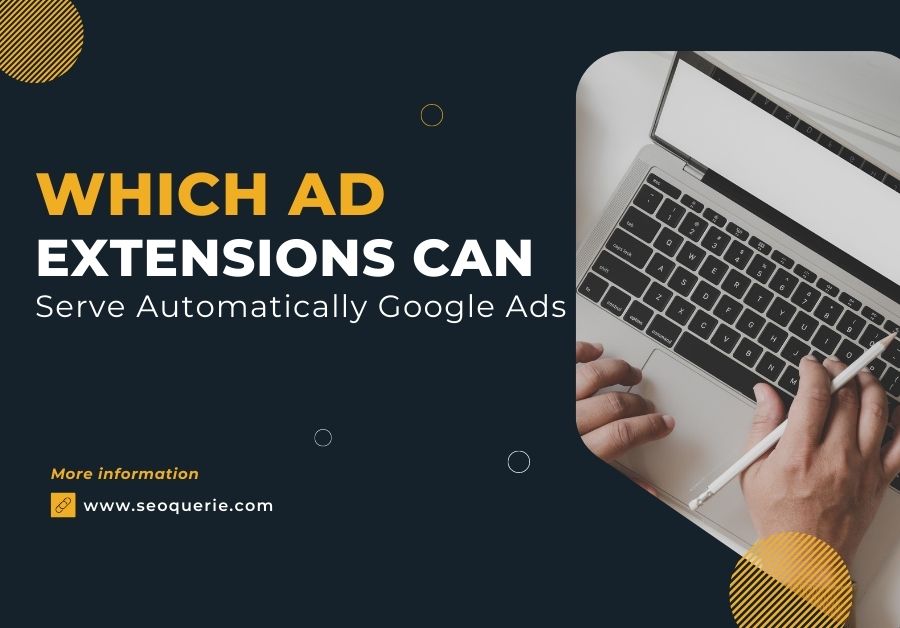In this blog, you are going to read about which ad extensions can serve automatically.
You’re probably aware that Google offers free ad extensions, but you don’t always want to go to the trouble of figuring out when to use them. Google solves this problem by providing automated extensions.
Which Ad Extensions Can Serve Automatically?
Answer:- Sitelink, callout, and structured snippets are the extensions that serve ads automatically.
What Are Automated Extensions and How Do They Work?
You don’t have to enter any information into Google’s automated extensions. Instead, Google Ads handles everything for you. The addon is then instantly displayed beneath your ad. When Google’s algorithms determine that the extension would boost the performance of your ad, it will do so.
Keep in mind that some ad extensions can only appear on laptop or desktop computers when you look at which ones can serve automatically. The majority, though, can be viewed on any device.
You can combine these extensions that serve automatically with manual extensions to make things easier.

Which ad extensions can provide automatically with the background information in mind?
Call Extensions that are Automated
If one of your aims is to promote calls, Google can put up automatic call extensions. When these extensions display on a mobile device, clicking on them will take the user to the phone app, which will already have your phone number dialed.
Extensions for Dynamic Callouts
People will see relevant information about your services and products if you use dynamic callout extensions. The objective is to persuade people to visit your website. These extensions can pull data from your site, such as “certified technicians” or “20 years of experience.”
Extensions for Dynamic Sitelinks
Sitelink extensions are add-ons that make it easier for customers to get to the parts of your website they want to visit. Consider when you see a company ad that includes links and display text for things like About Us, Hours, and Delivery in addition to a link to the website. These are usually found just beneath the headline or other content, separated by little dots.
Extensions for Dynamic Structured Snippets
Your ad’s structured snippets are extra descriptive text. They’re made to give you a better sense of the services and goods you’re considering. “Services: [a list of services]” is an example.
ways to boost revenue in unusual ways
Extensions for Location and Affiliate Location
These add-ons make it easy for browsers to locate your physical location. They may include your address, the distance between your business and the location of your business, or directions to your business. Affiliate location extensions are similar to affiliate location extensions in that they display merchants who carry your products. An affiliate location extension, for example, would highlight a nearby clothing store that carries your brand if you are a clothing brand.
Users can learn more about the extensions by clicking on them. A call button or your phone number is usually included in the extensions.
Fill in your location details.
While this is one of the answers that ad extensions can serve automatically, you should take a few minutes to double-check that your location information is correct. This is best accomplished by hand. If your account doesn’t have any locations, Google will still try to use these extensions, but it will do its best to match your business with locations it already knows about. It will then apply that data to your account. This increases the risk of inaccuracy, which is why manually entering your location data is preferable.
Extensions for Seller Ratings
Ads will automatically display reviews and rating information with these extensions. The idea is that it displays to users how highly rated your firm is, leading them to expect good service. These extensions are given a five-star rating. Both as a number and as stars are displayed.
Should You Use Any Extention Which serves ad Automatically?
The use of Google’s ad extensions is virtually always beneficial, especially because they are free. However, you don’t want to cram too many extensions into your ad. This may confuse readers or prevent your ad from fitting into some ad areas. You can stick with the automated extensions and let Google decide when they should be used. You can also select extensions based on your objectives.
- Consider location, affiliate location, and callout extensions if you want consumers to buy from your physical business.
- Choose call extensions if you want more people to contact you.
- Thinking price, structured snippets, callouts, or site link extensions to boost website conversions.
- Consider lead form extensions if you want to generate leads with contact information.
- Suppose app extensions if you want to increase the number of downloads of your mobile app.
- Whether you employ an extension in your ad or not, keep in mind that your keywords should have a high intent in relation to the user’s search query.
Is it necessary to pay a premium for automated extensions?
Extensions, especially automated extensions, are not charged extra by Google. You will, however, be charged the same rate as if someone clicked on the extension rather than the ad. If you have a call extension and use a pay-per-click model, everybody who calls your firm using the extension will be charged as a click. A user will only be charged per impression for up to two clicks on each ad, including extensions.
Conclusion: Which Ad Extensions Can Serve Automatically
This can save time and improve your capacity to achieve your goals by allowing the ad extensions that can serve automatically now that you know which ones can. You don’t have to worry because Google will automatically decide whether or not using the extensions will help you achieve your goals. Extensions, when implemented correctly, can help you reach any goal, whether it’s to increase revenue, gather data, or generate more hits.
Thanks For Reading By SEOQUERIE




